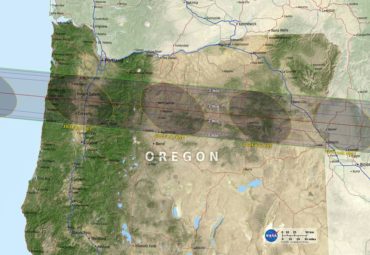
Are you still hoping to get a peek at the “Great American Eclipse” on Aug. 21? Millions of Americans will only have to drive 60 or 70 miles to see the total eclipse, according to the GreatAmericanEclipse.com website.
NASA says that the totality path, “where the moon will completely cover the sun and the sun’s tenuous atmosphere — the corona — can be seen, will stretch from Salem, Oregon to Charleston, South Carolina.” In Washington state, only partial eclipse will be seen.
According to NASA, the lunar shadow will enter USA near Lincoln City, on the Oregon coast, at 9:05 a.m., with the totality beginning at 10:16 a.m. at that location. From Port Orchard, Lincoln City is about 4.5 hours away by car.
Madras, Oregon (within a five-hour drive), is one of the best places to view the totality, which is estimated to last there 2 minutes, 4 seconds starting around 10:19 a.m. Madras is, naturally, expecting an influx of visitors, which means it’s party time: Oregon SolarFest will cater to the crowds with live music, food, helicopter rides, kids’ activities and other typical festival fare.
Other good viewpoints in Oregon include Lincoln City, Salem and Baker City. You can also catch the breathtaking view from Snake River Valley, Idaho, among other somewhat-close areas.
If you’re going to stay put, check out some of the local activities related to the event. And you can always watch it unfold live on the Science Channel.
Need a place to camp? It won’t be cheap but you may still be able to find a reasonably priced spot. Startup Hipcamp — sort of like the airbnb for camping — has partnered up with landowners to create new campsites on private property in the eclipse path.
According to Hipcamp, more than 1,300 new campsites have popped up around Oregon in the last month. Check the Hipcamp eclipse section for more details, including a map of all camping options for viewing the eclipse.
Here are some fun eclipse facts, courtesy of Hipcamp:
- The sun will put a ring on it.
In the last few seconds before the eclipse, sunlight streaming through the moon’s valleys creates a bright flash of light on the side of the moon known as the “diamond ring effect.” - Corona isn’t just a drink.
That glowing light halo around the dark solar eclipse has a name — it’s the “corona,” described by NASA as “the sun’s tenuous atmosphere.” - The 7-year itch is real.
The last solar eclipse on the West Coast occurred 38 years ago, so you don’t want to miss this opportunity. If you miss this eclipse, you’ll have to wait until April 8, 2024, for the next one. It will carve a path from Maine to Texas. - Our planets go the distance.
The Earth, moon and sun are currently perfect distances from each other, meaning we can see the corona during this eclipse. Millions of years ago, it was blocked. And millions of years in the future, total eclipses won’t be possible because the moon will appear smaller than the sun. - ‘Greece’ is the word.
The earliest predicted solar eclipse was in Ancient Greece in 585 B.C. It was seen as an omen — one that caused a long-standing battle between the Medes and the Lydians to finally end!
Don’t forget: You need special glasses to view the eclipse safely. Find all sorts of information on NASA’s special website, including information about safety.























